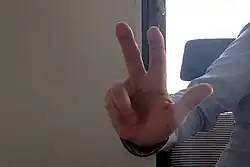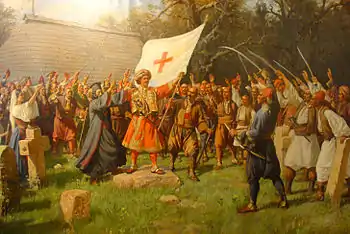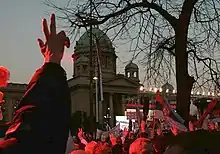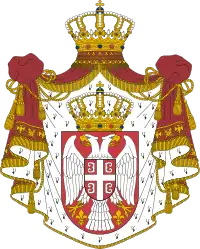
The three-finger salute (Serbian: поздрав са три прста, romanized: pozdrav sa tri prsta); or three fingers, (Serbian: три прста, romanized: tri prsta), commonly known as the Serbian salute (Serbian: српски поздрав, romanized: srpski pozdrav), is a salute which the thumb, index, and middle finger are extending. It originally expressed the Holy Trinity, used in oath-taking, and a symbol of Serbian Orthodoxy, while today simply is a gesture, distinctive sign for the ethnic Serb and a symbol for belonging to the Serbian nation.[1]
The salute usually goes along with the Serbian flag, using several semantic layers to depict its historical meaning, while also being used a symbol of Serbian ethno-nationalism.[2] However, the significance of the salute is diverse: although it has been widely used by nationalists, it cannot be monopolized as such; it has been used without aggressive nationalist connotations, i.e. at sport events.[3]
Origin
Orthodox symbolism

In Serbian and Orthodox tradition, the number three is exceptionally important.[4] Three fingers are used when signing the cross in Orthodoxy, symbolizing the Trinity. The Serbs, when swearing Oath, historically used the three fingers (collected, as when crossing) along with the greetings "My Holy Trinity" (Serbian: Светог ми Тројства / Svetog mi Trojstva) or "for the Honorable Cross and Golden Freedom" (за крст часни и слободу златну / za krst časni i slobodu zlatnu) during formal and religious events.[4] The salute was often made with both hands, raised above the head.[4] Serbian peasants sealed a pledge by raising three fingers to the face, the face being "the focus of honour" in Balkan culture.[5] A Serbian proverb goes "There is no cross without three fingers" (нема крста без три прста / nema krsta bez tri prsta).[6] Karađorđe was appointed leader of the Serbian rebels after they all raised their "three fingers in the air" and thereby swore Oath.[7]
The three fingers were viewed as a symbol of Serbdom in the 19th century. Njegoš mentioned "the crossing with three fingers has not remained" when speaking of the Islamization of Serbs, a central theme in the 1847 The Mountain Wreath.[8] The 1888 Paja Jovanović's painting, The Takovo Uprising, depicts Miloš Obrenović holding a war flag and saluting with three fingers.[4] The Serb-Catholic movement in Dubrovnik, which supported that Serbs had three faiths (Orthodoxy, Catholicism and Islam), criticized the Pan-Serbists who according to them only "truly believed those Serbs, who cross with three fingers".[9] A short story published in 1901 surrounds a Serbian despot meeting with a Szilágyi, who has the despot's three fingers cut off by Franciscan friars after discussing the right way of crossing.[10]
Serbian Metropolitan Nikolaj Velimirović called for a Serbian salute in which three fingers were to be raised along the greeting: "Thus Help Us God!".[11] In 1937, Velimirović began a sermon protesting the Catholic support for separation of state and religion in Yugoslavia with "Raise three fingers, Orthodox Serbs!".[12]
During World War II, the Catholic church in Independent State of Croatia sought that the Serbs renounce crossing with three fingers.[13] A letter from the Chetniks to the Yugoslav Partisans stressed that the real government was in London (in exile) and that they would kill all who did not cross themselves with three fingers.[14] An Ustashe song went "Gone is the crossing with three fingers" (Nesta krsta sa tri prsta) which was referred to Muslim daily ablution and the Orthodox way of making the sign of the cross.[15]
Modern form
Vuk Drašković, the leader of the Serbian Renewal Movement political party, said in a 2007 interview that he first used it in 1990 at the founding meeting of the party, inspired by Paja Jovanović's painting.[16] During the March 1991 street demonstrations in Belgrade, the three fingers were massively used by Drašković's supporters, representing the three demands that the Serbian Renewal Movement had put before the government.[17][18]
Usage
Nowadays, the salute is used in wide variety of events: from street demonstrations and celebrations, rallies during election campaigns (used by members and supporters of almost all Serbian political parties), to sporting events and personal celebrations (wedding and birthday parties).[3]
Usage by Serbian athletes is particularly visible. Serbian tennis player Novak Djokovic often raises three fingers after his victories.[19] In a famous photograph of the Red Star Belgrade team celebrating their victory at the 1990–91 European Cup, eight players are seen using the Serb salute, while a Croatian player, Robert Prosinečki, is not.[20] After winning the 1995 European basketball championship, the entire Serbia and Montenegro's team displayed the three fingers. Aleksandar Đorđević says he flashed the three fingers "not to be provocative. Just: that's Serbia, that's us, that's me – nothing else. It's my pride."[21] Serbian water polo player Aleksandar Šapić said in 2007 that "I know that it was used by soldiers in war, but I do not raise three fingers because I hate someone. I respect all peoples, and know what is in my heart."[22]
 2008 Kosovo is Serbia rally in Belgrade
2008 Kosovo is Serbia rally in Belgrade.jpg.webp) 2012 Boris Tadić electoral rally
2012 Boris Tadić electoral rally NBA basketball player Aleksandar Pavlović displaying the three-finger salute
NBA basketball player Aleksandar Pavlović displaying the three-finger salute Serbian White Eagles FC players and fans celebrate victory
Serbian White Eagles FC players and fans celebrate victory
Controversy
A 1998 Serbian daily newspaper Politika published an article that spoke of the "perennial demonization" of the salute, "which had already entered the catalogue of planitarian gestures", together with the closed fist, outstretched palm and V sign.[23]
Croats, Bosniaks, and Kosovar Albanians, who have been at war with Serbs in the past, find the salute provocative.[24]
Yugoslav wars
During the Yugoslav Wars, the salute was widely used as a Serb symbol. In the prelude of the Bosnian War, Bosnian Serbs were encouraged to vote in the 1991 referendum through posters which displayed the three fingers.[25] During the wars, Serb soldiers raised the three fingers as a sign of victory.[26][27]
When Russian peacekeeping troops entered Sarajevo in 1994, they used the salute when greeting the Serb troops,[28] and because of this, they were branded pro-Serb; the UNPROFOR used the Serb salute when greeting the Serbs, and the V sign when greeting the Bosniaks, showing impartiality.[29]
In 2006, the United Nations published the case titled IT-00-39-T from the International Criminal Tribunal for the former Yugoslavia, describing several atrocities committed by Serb military and police forces on Bosniak and Croatian civilians on 20 July 1992, in the villages Keratem, Omarska and Trnopolje. Detaines were executed, humiliated, and were forced to spit on the Bosnian flag and do the three-finger sign.[30]
There were instances when non-Serb captives were forced to use the salute.[31] According to a BBC documentary about the Srebrenica massacre, Bosnian Serb forces transported Bosnian civilians in buses to the village of Tisca. During the travel the civilians saw Chetniks showed the three-finger symbol and when they arrived, Serb police forces forced them to surrender them to hand over gold and jewellery and threatening to chop off the women's breasts.[32][33]
In 2008, The Bosnian newspaper Oslobođenje published a coverage of the arrest of Radovan Karadžić. The paper accusingly compared the leaders of Republic Srpska with those of the wartime era in the front paper depicting Milorad Dodik next to Karadžić with a photograph of Dodik giving the three-fingered salute during the war.[34]
In 1999, Human Rights Watch obtained photographs from the KLA administration in Peć depicting Serb soldiers carrying assault rifle, doing the three-finger salute and standing in front of burning houses.[35] KLA officials told the Human Rights Watch that the photographs had been found in the homes of ethnic Serb citizens in the Peć area after Serbian forces withdrew from Kosovo earlier that year.
In 1999, after the NATO bombing of Serbia, Colin Woodard wrote about thousands of Serbian Americans who filled the park opposite the White House on Pennsylvania Avenue, shouting "Kosovo is Serbia" and "Stop the bombing", while wearing military caps and making the three-finger salute.[36]
In 2001, after the end of the Kosovo war, the UCPMB forces were to hand over themselves to the KFOR, however, an incident occurred when Serb forces shot dead a UCPMB senior commander (who was not keen on the agreement with the KFOR) as he accidentally drove into a village where Serb generals led a parade giving the Serbian three fingered salute.[37]
Recent controversies
2007 Eurovision winner Marija Šerifović used the salute when celebrating points; controversially, she used the salute when receiving the maximum of 12 points from Bosnian viewers, after which Bosnian media reported it as being used as a direct provocation.[38][39] The Swedish-Serbian National Association called it 'ridiculous', saying that the salute is not to be mistaken in that way, but viewed of as nothing more than 'a modified V sign', even though the three finger salute is older than the V sign.[40]
Rade Leskovac, president of a Serb minority party in Croatia, caused controversy in 2007 when election posters featuring him with the salute were posted around Vukovar.[41]
In 2001, Australian football team Perth Glory's Bobby Despotovski (of Serbian parentage) was sanctioned by the Australian Soccer Federation for giving the salute to the predominantly Croatian-community crowd at a Melbourne Knights home game and inciting a fight; Despotovski and coach Bernd Stange were subsequently assaulted by Knights fans, forcing the next fixture between the sides to be moved to Launceston.[42]
The salute was met with controversy in Turkey after Duško Tošić, playing for Beşiktaş, used the salute after Serbia won over Albania in the guest match in the UEFA 2016 qualifiers; Beşiktaş fans threatened him through Turkish media.[43]
In the 2022 World Cup, FIFA opened a disciplinary case against Croatian fans following their taunting of the Canadian goalkeeper Milan Borjan, born in an ethnic Serb region of Croatia that was part of the conflict in the 1990s.[44] Fans chanted 'Borjan is an Ustaša', referring to the pro-Nazi regime which exterminated Serbs, Gypsies, and Jews in Croatia and Bosnia during World War II. In response to the taunting, he showed the three-finger salute.
See also
References
- ↑ Anamaria Dutceac Segesten (16 September 2011). Myth, Identity, and Conflict: A Comparative Analysis of Romanian and Serbian Textbooks. Lexington Books. p. 145. ISBN 978-0-7391-4867-9.
- ↑ Gligorijević, Jelena (2019). Contemporary Music Festivals as Micronational Spaces: Articulations of National Identity in Serbia's Exit and Guča Trumpet Festivals in the Post-Milošević Era. Finland: University of Turku. pp. 199–200. ISBN 978-951-29-7594-5. Retrieved 4 January 2020.
- 1 2 Anamaria Dutceac Segesten (16 September 2011). Myth, Identity, and Conflict: A Comparative Analysis of Romanian and Serbian Textbooks. Lexington Books. p. 145. ISBN 978-0-7391-4867-9.
- 1 2 3 4 A. Palić (7 December 2013). "Prkos raširio tri prsta". Novosti.
- ↑ Traian Stoianovich (1 September 1994). Balkan Worlds. M.E. Sharpe. p. 48. ISBN 978-0-7656-3851-9.
- ↑ Vladimir Ćorović (1921). Pokreti i dela. Izdavačka knjižarnica Gece Kona. p. 9.
- ↑ M. Đ Milićević (1876). Knez̆evina Srbija. Vol. 1. Sloboda. p. 251.
- ↑ Лазо М Костић (2000). Његош и српство. Српска радикална странка. p. 250. ISBN 978-86-7402-035-7.
- ↑ Izviesca brzopisna i analiticna ... zasjedanja zemaljskoga sabora dalmatinskoga od dneva ... do ... 18 ... , u koji dan zasjedanje bi odgodjeno. (Stenograph. und analyt. Mitteilungen der ... Session der dalmatischen Landesversammlung.)- U Zadru, Narodnogo Lista 1870-(serbocroat. et ital.). Narodnogo Lista. 1899. p. 604.
- ↑ Brankovo kolo za zabavu, pouku i književnost. Vol. 7. 1901. p. 103.
- ↑ Радмила Радић (2006). Живот у временима: Гаврило Дожић 1881-1950. Институт за новију историју Србије. p. 178. ISBN 978-86-7005-047-1.
Тако нам Бог помогао!
- ↑ Vjekoslav Perica (2002). Balkan Idols: Religion and Nationalism in Yugoslav States. Oxford University Press. p. 18. ISBN 978-0-19-517429-8.
- ↑ Ivan Cvitković (1986). Ko je bio Alojzije Stepinac. Izdavačka djelatnost. p. 113.
- ↑ Hodimir Sirotković; Institut za historiju radničkog pokreta (Zagreb, Croatia) (1964). Zemaljsko antifašističko vijeće narodnog oslobodenja Hrvatske: zbornik dokumenata 1943. Institut za historiju radničkog pokreta. p. 458.
U tom pismu se naglašava, da četnici imaju vladu u Londonu i da će ubijati sve one koji se ne krste s tri prsta.
- ↑ Jozo Tomasevich (2001). War and Revolution in Yugoslavia: 1941 - 1945. Stanford University Press. pp. 353, 35. ISBN 978-0-8047-7924-1.
- ↑ "Tri prsta za pobedu" (in Serbian). Večernje novosti. 17 November 2007.
- ↑ "Tri Srbije?". B92 Editorial. 10 October 2002.
- ↑ "3 Prsta". Kurir. 11 November 2006.
Lepo ste se toga setili! Podignuta tri prsta jesu simbol koji je u masovnu upotrebu uveo Vuk Drašković na mitingu u Beogradu 13. marta 1991. godine. Tada je SPO imala tri zahteva, a jedan od njih je bio da se puste svi pohapšeni 9. marta. To je bio naš simbol borbe za promene, a iako je trebalo dosta vremena da se taj simbol prihvati, očigledno je da je uspelo. I kada ga danas koriste radikali, nemam ništa protiv – kaže Srećković.
- ↑ "Lekar iz Tuzle: Otvoreno pismo Novaku Đokoviću". Story. Archived from the original on 15 September 2014. Retrieved 1 March 2016.
- ↑ Jonathan Wilson (9 April 2012). Behind the Curtain: Football in Eastern Europe. Orion. p. 74. ISBN 978-1-4091-0904-4.
- ↑ "Prisoners of War". Sports Illustrated. 1996. Archived from the original on 17 July 2007.
- ↑ NIN: nedeljne informativne novine. Politika. September 2007.
Знам да су то користили војници у рату, али ја три прста не ди- жем зато што неког мрзим. Ја све љу- де поштујем, и знам шта ми је у срцу
- ↑ NIN. Nedeljne informativne novine. Vol. 2454–2465. Politika. 1998. p. 41.
Ријеч је о вишегодишњој демонизацији „поздрава с три прста", који је већ ушао у каталог планетарних геста, заједно са стиснутом шаком, испруженим дланом, и прстима у положају за слово В, а првим се означава „љевичарски" ...
- ↑ John Hughson; Fiona Skillen (14 October 2015). Football in Southeastern Europe: From Ethnic Homogenization to Reconciliation. Routledge. pp. 47, 90. ISBN 978-1-317-74929-5.
- ↑ "960531". ICTY. Archived from the original on 9 March 2001.
{{cite web}}: CS1 maint: bot: original URL status unknown (link) - ↑ Danas. Vol. 494–504. 1991. p. 37.
- ↑ Martin Grgurovac (1992). Vinkovački ratni dnevnik: dnevnički zapisi od 30.IV.1991. do 16.V.1992. Slavonska nadlada "Privlačica". p. 131.
- ↑ "A Three-Finger Salute". The Christian Science Monitor. 2 February 1994.
- ↑ United States. Congress. House. Committee on National Security (1 January 1997). United States Policy Toward the Former Yugoslavia: Hearings Jeld June 7, 1995, July 11, 1995, October 17, 18, 1995, November 2, 8, 15, 30, 1995, December 6, 1995 and September 25, 1995. U.S. Government Printing Office. p. 149. ISBN 978-0-16-054094-3.
- ↑ Mr Hans Holthuis, Judge Alphons Orie, Presiding Judge Joaquín Martín Canivell Judge Claude Hanoteau (2006). Before: Registrar: Judgement of: International Tribunal for the Prosecution of Persons Responsible for Serious Violations of International Humanitarian Law Committed in the Territory of the Former Yugoslavia since 1991 (PDF) (Prosecutor v. Momčilo Krajišnik. Case: IT-00-39-T Date: 27 September 2006 Original: English ed.). United Nations. p. 184.
{{cite book}}: CS1 maint: multiple names: authors list (link) - ↑ Michigan Law Review. Vol. 96. University of Michigan, Department of Law. 1998. p. 2049.
- ↑ Mrs. Dorothee de Sampayo Garrido-Nijgh, Judge Gabrielle Kirk McDonald, Presiding Judge Ninian Stephen Judge Lal Chand Vohrah (1997). International Tribunal for the Prosecution of Persons Responsible for Serious Violations of International Humanitarian Law Committed in the Territory of Former Yugoslavia since 1991 (PDF) (Case No. IT-94-1-T: The Office of the Prosecutor: Mr. Grant Niemann Mr. William Fenrick Counsel for the Accused: Mr. Michaïl Wladimiroff Mr. Alphons Orie Ms. Brenda Hollis Mr. Michael Keegan Mr. Steven Kay Ms. Sylvia de Bertodano Mr. Alan Tieger Mr. Milan Vujin Mr. Nikola Kosti} ed.). Retrieved 4 January 2020.
{{cite book}}: CS1 maint: multiple names: authors list (link) - ↑ "The Fall of Srebrenica and the Failure of UN Peacekeeping | Bosnia and Herzegovina". Human Rights Watch (Human Rights Watch. 350 Fifth ed.). 1995. Retrieved 4 January 2020.
- ↑ Marcus Tanner, Nidzara Ahmetasevic (2009). History oversHadowed by trivia. Regional Media Coverage of Radovan Karadzic Arrest (PDF) (Publisher: birN bih in cooperation with the Konrad Adenauer Foundation, sarajevo, 2009. PublicAtioN editors: Nidzara Ahmetasevic and Marcus tanner editoriAl teAM: Gordana igric, Ana Petruseva MoNitors: Nidzara Ahmetasevic and Merima husejnovic ProoFreAdiNG: Nadira Koric (bosnian/croatian/serbian) and Anna Mctaggart (english) trANslAtioN: sunita hasic and haris Nezirovic dtP: lorko Kalas ed.). Sarajevo. pp. 34–35. Retrieved 4 January 2020.
{{cite book}}: CS1 maint: location missing publisher (link) - ↑ Watch, Human Rights (1999). A VILLAGE DESTROYED: War Crimes in Kosovo (PDF) (Vol. 11, No. 13 (D) ed.).
- ↑ Woodard, Colin (1999). "NATO throws itself a party". The Bulletin of the Atomic Scientists ("An angry crowd of Serbian-Americans filled the park opposite the White House on Pennsylvania Avenue, but the scene was straight out of Bel- grade. The demonstrators already numbered several thousand, and they were growing by the busload. Young, old, and in-between, they donned "NATO Target" t-shirts and buttons. They chanted "Kosovo is Serbia!" and "Stop the Bombing". Men sported military caps and berets. Teenagers waved Serbian flags and made three-fingered stiff-armed salutes. Whis- tles and bullhorns made a powerful din. Signs read "Words not Weapons", "Stop the Third Ex- termination of the Serbs", and "Why Serbia?" ed.). 55 (4): 38. doi:10.2968/055004012.
- ↑ Churcher, Bob (2003). Conflict Studies Research Centre. A continuing cause for concern. Kosovo/Preshevo (PDF) (Preshevo/Kosovo Lindore - A Continuing Cause For Concern Conflict Studies Research Centre ISBN 1-904423-22-1 February 2003 ed.). p. 6. Retrieved 4 January 2020.
- ↑ "Tajni znakovi Eurosonga: Kome je Marija podigla tri prsta?". SINA. Archived from the original on 8 October 2007.
- ↑ Georg Cederskog (13 May 2007). "Schlagertävlingen hotar bli politiserad". Dagens Nyheter.
- ↑ Serbernas riksförbund i Sverige; et al. (17 May 2007). "Missförstå inte våra serbiska tre fingrar". Aftonbladet.
- ↑ "Nepoželjna "tri prsta" u hrvatskoj izbornoj kampanji" (in Serbian). RTS. 16 November 2007.
- ↑ "Bobby admits salute". theworldgame.sbs.com.au. The World Game. 8 May 2001. Archived from the original on 20 October 2017. Retrieved 16 May 2023.
- ↑ "Ne Prestaju Da Prete Tošiću Tri prsta su zabranjena u Turskoj!". Alo.
- ↑ "Croatia Charged For World Cup Fans Taunts of Canadian Goalie". CP24. 29 November 2022.
External links
 Media related to Three-finger salute (Serbian) at Wikimedia Commons
Media related to Three-finger salute (Serbian) at Wikimedia Commons
